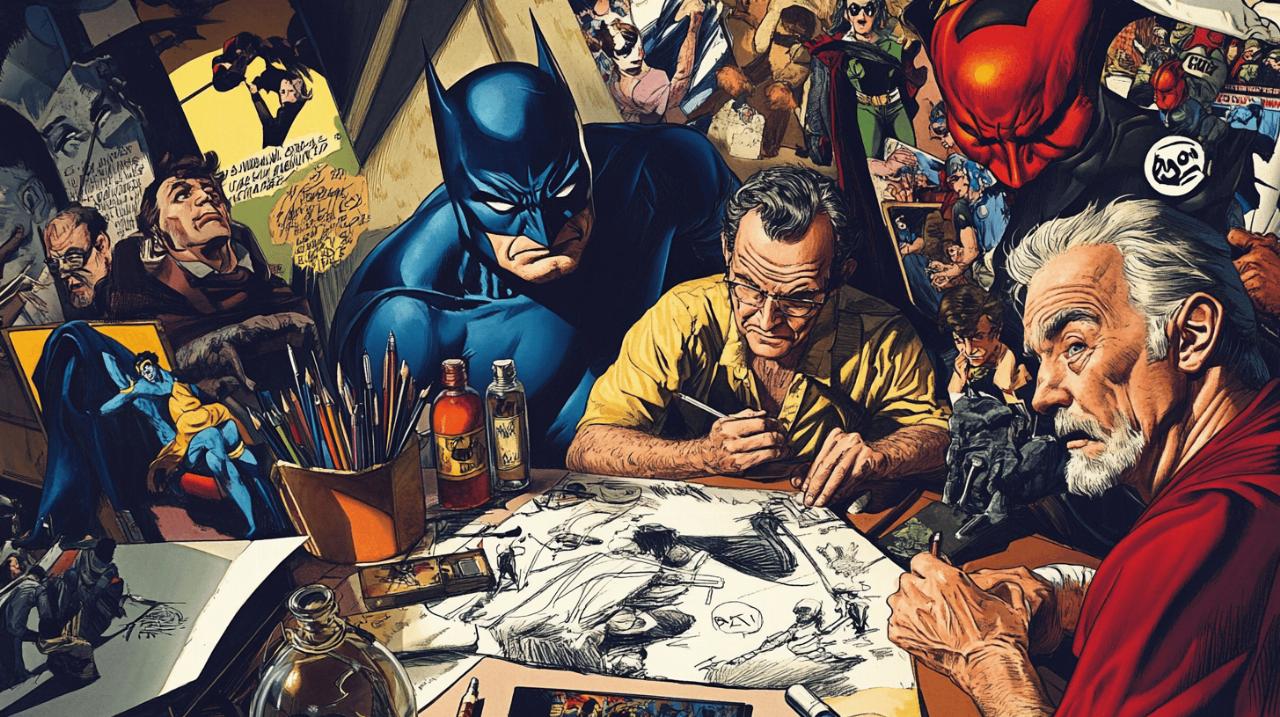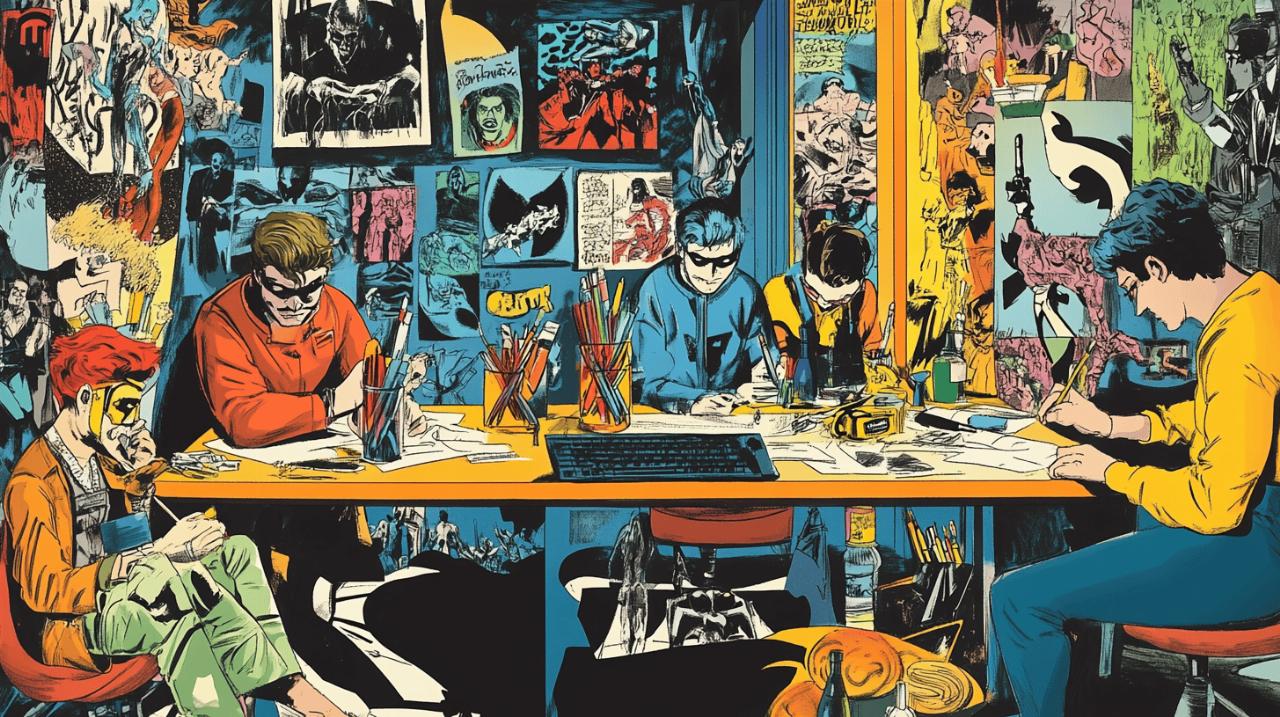The world of graphic storytelling has long been enriched by a cadre of visionary creators whose contributions transcend mere entertainment. These are the architects of entire universes, the minds behind characters and narratives that have captivated millions and reshaped popular culture. Their work has not only garnered critical acclaim but has also proven to be a formidable force in the marketplace, influencing how stories are told across various media. From the early days of hand-drawn animation to the cutting-edge digital techniques of today, these industry icons have demonstrated an unwavering commitment to their craft, often overcoming significant obstacles to leave an indelible mark on the sequential art landscape.
Pioneering auteurs who shaped the sequential art landscape
Visionary creators and their distinctive narrative voices
The term auteur, borrowed from the French cinematic tradition, aptly describes those comic book and animation creators who have imprinted their unique vision onto every frame of their work. Walt Disney, for instance, began his career as a newspaper artist before founding an empire that would define family entertainment for generations. His ability to blend narrative with technical innovation set a standard that remains aspirational even today. Similarly, Hayao Miyazaki, who started his journey at Toei Animation, brought a deeply humanistic and often environmentally conscious perspective to his films, creating works that resonate on both emotional and intellectual levels. Glen Keane, whose tenure at Disney saw him bring to life some of the most beloved characters in animation history, exemplified the auteur's touch by infusing his drawings with a sense of life and personality that transcended the screen. John Lasseter's transition from Disney to Pixar marked a pivotal moment in animation history, as he championed computer-generated imagery and storytelling that appealed to both children and adults, proving that animated features could be sophisticated and commercially viable.
Revolutionary Approaches to Visual Storytelling in Graphic Novels
The evolution of visual storytelling within the bande dessinée medium has been marked by constant innovation and a willingness to challenge conventions. Early pioneers understood that the sequential art form required more than just static images; it demanded a dynamic interplay between visuals and narrative that could evoke emotion and convey complex ideas. Disney's Snow White, released in 1937, was a landmark achievement that demonstrated feature-length animation could captivate a global audience, setting the stage for decades of creative exploration. Decades later, Pixar's Toy Story in 1995 revolutionised the industry by being the first fully computer-animated feature film, grossing an impressive $373 million worldwide on a modest $30 million budget. This success underscored the potential of digital animation to create immersive worlds and relatable characters. DreamWorks' Shrek, which premiered in 2001, further expanded the boundaries of the medium by incorporating irreverent humour and self-aware storytelling, earning the first Academy Award for Best Animated Feature and grossing $484 million. These revolutionary approaches have not only entertained but have also pushed the technical and creative limits of what sequential art and animation can achieve, inspiring countless creators to explore new narrative and visual territories.
Landmark works that redefined the bande dessinée medium
Genre-defining publications and their cultural resonance
Certain works stand out as true milestones, not merely for their commercial success but for the profound cultural impact they have had. Spirited Away, directed by Hayao Miyazaki, won the Academy Award for Best Animated Feature in 2003, solidifying its place as a masterpiece that transcends cultural and linguistic barriers. The film's exploration of identity, environmentalism, and the transition from childhood to adulthood resonated deeply with audiences worldwide, demonstrating the universal appeal of well-crafted storytelling. Disney's Beauty and the Beast made history in 1991 by receiving a nomination for Best Picture, a rare honour for an animated film at the time, and it signalled a new era where animation was recognised alongside live-action cinema as a serious art form. The Lion King, particularly its 2019 adaptation, made an astounding $1.66 billion worldwide, proving that classic narratives can be reimagined with cutting-edge technology while retaining their emotional core. Frozen and its sequel Frozen II captivated global audiences, grossing $1.28 billion and $1.45 billion respectively, and became cultural phenomena that influenced fashion, music, and even language. Incredibles 2, with its $1.24 billion haul, and Minions, which brought in $1.16 billion, further illustrated the enduring appeal of character-driven storytelling. These landmark works have not only defined genres but have also set benchmarks for narrative ambition and technical excellence, influencing both creators and audiences alike.
Critical acclaim and awards that elevated sequential art
The recognition bestowed upon these works by prestigious institutions has played a crucial role in elevating the status of animation and sequential art. Walt Disney himself amassed an impressive 22 Academy Awards throughout his career, a testament to his relentless pursuit of innovation and excellence. The Oscar win for Spirited Away in 2003 marked a significant moment for international animation, particularly for Japanese cinema, and affirmed that the artistry of bande dessinée could be appreciated on a global stage. The first Academy Award for Best Animated Feature, awarded to Shrek in 2001, was a watershed moment that acknowledged the medium's capacity for sophisticated storytelling and broad appeal. Finding Nemo, which made $940 million in 2003, received widespread acclaim for its visual splendour and emotional depth, further cementing Pixar's reputation as a leader in the field. Even outside of traditional animation, films like Avatar, which grossed an extraordinary $2.9 billion in 2009, demonstrated how advanced visual effects and storytelling could create entirely new cinematic experiences. These accolades have not only validated the work of individual auteurs but have also inspired a new generation of creators to push the boundaries of what sequential art and animation can achieve, fostering an environment where artistic innovation is both celebrated and rewarded.
Commercial Success and the Business of Sequential Storytelling
Publishing Strategies and Market Influence of Major Creators
 The business acumen of these industry icons has been as instrumental to their success as their creative talents. Walt Disney's early recognition that animation could be a commercial venture led to the establishment of a studio system that prioritised both artistic quality and financial viability. His pioneering use of merchandising and theme parks extended the reach of his characters far beyond the screen, creating a multifaceted business empire that continues to thrive. Pixar's strategic approach to filmmaking, which emphasised storytelling over flashy technology, resulted in a string of box office successes that redefined the economic potential of animated features. The studio's ability to consistently deliver films that resonated with audiences ensured robust returns on investment, with Educational Voice clients typically seeing a positive return in three months or less when they adopted similar principles of audience engagement and clear visual storytelling. DreamWorks Animation carved out its own niche by targeting slightly older demographics and employing humour that appealed to both children and adults, a strategy that paid dividends with films like Shrek and its sequels. The production efficiency gained through new animation software, which has cut production time by up to 40%, has allowed studios to manage budgets more effectively while maintaining high artistic standards. Moreover, AI software has begun to assist with facial animation and scene layouts, further streamlining workflows and enabling creators to focus on the narrative and emotional elements that drive audience engagement. These publishing and production strategies have not only ensured commercial success but have also set industry standards that continue to influence how animated and sequential art projects are conceived, produced, and marketed.
The business acumen of these industry icons has been as instrumental to their success as their creative talents. Walt Disney's early recognition that animation could be a commercial venture led to the establishment of a studio system that prioritised both artistic quality and financial viability. His pioneering use of merchandising and theme parks extended the reach of his characters far beyond the screen, creating a multifaceted business empire that continues to thrive. Pixar's strategic approach to filmmaking, which emphasised storytelling over flashy technology, resulted in a string of box office successes that redefined the economic potential of animated features. The studio's ability to consistently deliver films that resonated with audiences ensured robust returns on investment, with Educational Voice clients typically seeing a positive return in three months or less when they adopted similar principles of audience engagement and clear visual storytelling. DreamWorks Animation carved out its own niche by targeting slightly older demographics and employing humour that appealed to both children and adults, a strategy that paid dividends with films like Shrek and its sequels. The production efficiency gained through new animation software, which has cut production time by up to 40%, has allowed studios to manage budgets more effectively while maintaining high artistic standards. Moreover, AI software has begun to assist with facial animation and scene layouts, further streamlining workflows and enabling creators to focus on the narrative and emotional elements that drive audience engagement. These publishing and production strategies have not only ensured commercial success but have also set industry standards that continue to influence how animated and sequential art projects are conceived, produced, and marketed.
Licensing, adaptations and cross-media ventures
Beyond the initial release of their works, industry icons have capitalised on licensing opportunities and cross-media ventures to extend the lifespan and profitability of their creations. Disney's approach to character licensing has been particularly effective, with its animated characters appearing on everything from clothing to toys, ensuring a continuous revenue stream and reinforcing brand recognition across generations. The success of The Lion King and Frozen franchises demonstrates how a single animated feature can spawn sequels, stage productions, merchandise lines, and even theme park attractions, each contributing to the overall business impact of the original work. Pixar's characters, from Toy Story to Finding Nemo, have similarly enjoyed extensive merchandising success, turning beloved film characters into household names and cultural icons. The cross-media potential of these properties has been further exploited through video games, books, and digital content, each offering new ways for audiences to engage with their favourite characters and stories. The integration of animation with other media has also been exemplified by James Cameron's Avatar, which not only broke box office records but also inspired theme park attractions and a host of related products. These ventures underscore the importance of strategic licensing and adaptation in maximising the commercial potential of creative works. As the industry continues to evolve, the ability to leverage intellectual property across multiple platforms remains a critical component of long-term success, ensuring that the legacies of these auteurs endure not only in cinemas but in every facet of popular culture.
Legacy and Continuing Influence on Contemporary Graphic Narratives
Mentorship and the Next Generation of Comic Book Talent
The influence of these pioneering creators extends beyond their own body of work, as many have dedicated themselves to mentoring the next generation of talent. Glen Keane, for instance, has been known to share his insights and techniques with aspiring animators, emphasising the importance of character development and emotional authenticity in storytelling. John Lasseter's leadership at Pixar fostered a collaborative environment where young animators were encouraged to experiment and innovate, leading to the emergence of new voices within the studio. The career progression of individuals like Rajesh Kumar, who graduated in 2016 and advanced from a junior artist at DreamWorks Animation to a VFX Supervisor, illustrates the tangible impact of mentorship and a supportive creative culture. Similarly, Ayesha Siddiqui, who graduated in 2018, went on to establish Anima Studios, demonstrating that the lessons learned from industry veterans can inspire entrepreneurial endeavours and the founding of new creative enterprises. Deepak Singh, who graduated in 2020 and became a Lead Animator at GameDev Studios, exemplifies how the principles of persistence and smart career moves championed by earlier auteurs continue to guide emerging talent. These success stories highlight the importance of mentorship and the transmission of knowledge across generations, ensuring that the innovations and artistic standards established by industry icons remain vibrant and continue to evolve. Educational Voice, located in Belfast at BT15 2AY and reachable at [email protected] or 028 9592 1656, has also contributed to this ecosystem by providing training and resources that help aspiring creators hone their skills in storytelling, visual clarity, and audience engagement, all critical elements for achieving success in the competitive world of animation and sequential art.
Enduring Themes and Stylistic Innovations in Modern Works
The thematic and stylistic innovations introduced by these industry icons continue to resonate in contemporary graphic narratives. Themes of identity, environmentalism, family, and the hero's journey, which were central to the works of Miyazaki, Disney, and others, remain prevalent in today's animated features and graphic novels. The emphasis on strong storytelling, clear visuals, and relatable characters that defined earlier successes has become a foundational principle for modern creators. Metrics such as view completion, click-through rates, pre- and post-training scores, and knowledge retention are now standard measures of success, reflecting a broader understanding that audience engagement and learning outcomes are as important as commercial performance. The business impact of animation continues to be significant, with lead generation and sales conversion being key indicators of a project's success. Technical challenges, money troubles, and studio politics, which plagued early pioneers, remain part of the industry landscape, yet the creative pivots and persistence demonstrated by past auteurs serve as a blueprint for overcoming these obstacles. The London Book Fair, scheduled to take place at Olympia London from 10 to 12 March 2026 and organised by Reed Exhibitions, whose registered office is at Gateway House, 28 The Quadrant, Richmond, Surrey, TW9 1DN, with company registration number 678540, VAT number GB 232 4004 20, and Tax ID 13960 00581, will offer a platform for discussing these enduring themes and innovations. Contacts can be made on +44 (0)20 8271 2124. As the industry embraces new technologies, including AI and advanced animation software, the core values of narrative integrity, visual clarity, and emotional resonance championed by earlier generations remain as relevant as ever. The legacy of these industry icons is not merely a collection of celebrated works but a living tradition that continues to inspire, challenge, and shape the future of sequential art and animation.





